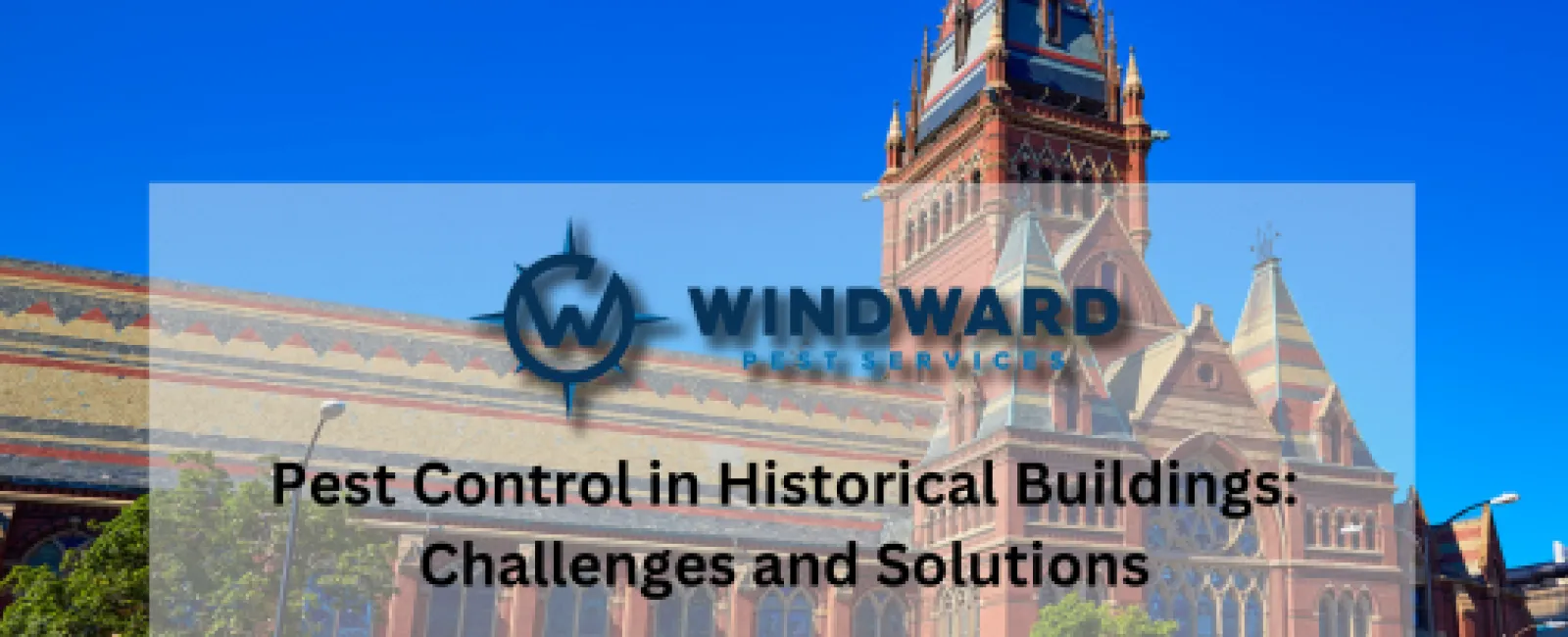Historical buildings are a treasure trove of architectural beauty and cultural significance. Preserving these structures is essential, but it comes with unique challenges, particularly when it comes to pest control. Pests can cause significant damage to the delicate materials used in older buildings, threatening their structural integrity and historical value. In this comprehensive guide, we will explore the challenges of pest control in historical buildings and offer effective solutions. Windward Pest Services, a leader in Atlanta pest control, provides expert strategies to protect these cherished structures from the ravages of pests.
Understanding the Unique Challenges of Historical Buildings
Historical buildings, by their very nature, present distinct challenges for pest control. These challenges arise from the age, materials, and design of the structures, as well as the need to balance preservation with pest management.
1. Age and Deterioration
Over time, historical buildings can suffer from wear and tear, leading to cracks, gaps, and other vulnerabilities that pests can exploit. The aging materials may also be more susceptible to pest infestations, especially wood, which can attract termites and wood-boring insects.
- Solution: Regular maintenance and timely repairs are crucial. Conduct thorough inspections to identify and address any areas of deterioration that could invite pests. Consider partnering with Windward Pest Services and our pest inspections to ensure that all potential entry points are secured.
2. Unique Materials
Many historical buildings are constructed using materials that are no longer commonly used today, such as untreated wood, natural stone, and lime mortar. These materials may not be as resistant to pests as modern alternatives, making them more vulnerable to infestation.
- Solution: Work with pest control experts who have experience dealing with older materials. Atlanta's Windward Pest Services' residential and commercial pest services can provide tailored treatments that are effective yet gentle on these delicate materials.
3. Architectural Design
The intricate design features of historical buildings, such as ornate moldings, hidden crawl spaces, and intricate woodwork, can provide ideal hiding spots for pests. These features can also make it challenging to detect and treat infestations.
- Solution: Utilize advanced pest detection methods, such as thermal imaging and moisture meters, to uncover hidden infestations. Windward's Atlanta interior and exterior pest treatments can be customized to target these hard-to-reach areas without damaging the building's design.
4. Preservation Regulations
Preserving the historical integrity of a building often means adhering to strict regulations that can limit the types of pest control treatments that can be used. This can make it difficult to implement traditional pest control methods.
- Solution: Choose eco-friendly and non-invasive pest control options that comply with preservation regulations. Integrated Pest Management (IPM) strategies, which focus on prevention and minimal chemical use, are particularly effective in historical buildings.
Common Pests in Historical Buildings
Several types of pests are commonly found in historical buildings. Understanding the behavior and risks associated with these pests is essential for developing an effective pest control strategy.
1. Termites
Termites are one of the most destructive pests, particularly in buildings with wooden structures. They can cause extensive damage by eating away at the wood, weakening the building's framework.
- Solution: Regular termite inspections are vital. Windward Pest Services can identify early signs of termite activity and implement treatments such as baiting systems and barrier treatments to protect the building.
2. Wood-Boring Insects
In addition to termites, other wood-boring insects, such as beetles and carpenter ants, can infest historical buildings. These pests burrow into the wood, causing structural damage over time.
- Solution: Inspect wooden elements regularly for signs of infestation, such as small exit holes or sawdust-like frass. Consider using borate treatments, which are effective against wood-boring insects and safe for historical materials.
3. Rodents
Rodents, such as mice and rats, are attracted to historical buildings for shelter and food. They can gnaw through wood, wiring, and insulation, leading to damage and potential fire hazards.
- Solution: Implement rodent exclusion techniques, such as sealing entry points and installing rodent-proof barriers. Traps and bait stations can be strategically placed to control rodent populations without compromising the building's aesthetics.
4. Bats and Birds
Bats and birds often seek refuge in the attics, eaves, and rafters of historical buildings. Their droppings can cause damage to the building's exterior and pose health risks to occupants.
- Solution: Install bird and bat deterrents, such as netting and spikes, to prevent them from roosting. For existing infestations, humane removal methods should be employed, followed by thorough cleaning and disinfection.
5. Cockroaches and Ants
Cockroaches and ants are attracted to food and moisture, making kitchens and basements in historical buildings common hotspots for these pests.
- Solution: Maintain a clean environment, particularly in areas where food is stored or prepared. Windward's Atlanta pest control services can provide targeted treatments to eliminate these pests and prevent future infestations.
Effective Pest Control Solutions for Historical Buildings
Successfully managing pests in historical buildings requires a combination of preventive measures, regular inspections, and targeted treatments. Here are some of the most effective solutions.
1. Integrated Pest Management (IPM)
IPM is a holistic approach to pest control that emphasizes prevention, monitoring, and minimal chemical use. This approach is particularly well-suited to historical buildings, where preservation is a priority.
- Components of IPM:
- Monitoring: Regular inspections to detect pest activity early.
- Prevention: Implementing measures to reduce the risk of infestations, such as sealing entry points and maintaining cleanliness.
- Control: Using targeted treatments, such as baits, traps, and non-toxic repellents, to manage pest populations.
Windward Pest Services' Atlanta residential and commercial pest services can develop a customized IPM plan tailored to the unique needs of your historical building.
2. Non-Toxic Treatments
When dealing with historical buildings, it's essential to use pest control treatments that won't harm the building materials or pose risks to occupants. Non-toxic treatments, such as diatomaceous earth, essential oil sprays, and heat treatments, are effective alternatives to traditional pesticides.
- Benefits:
- Safe for use in sensitive environments.
- Effective against a wide range of pests.
- Minimal impact on the building's structure and materials.
Windward's Atlanta interior and exterior pest treatments can incorporate these non-toxic options to protect your historical building while maintaining its integrity.
3. Structural Repairs and Maintenance
Preventive maintenance is key to keeping pests out of historical buildings. Regular inspections and timely repairs can address vulnerabilities before they become major issues.
- Maintenance Tips:
- Seal Cracks and Gaps: Regularly inspect the building's exterior for cracks and gaps and seal them promptly.
- Repair Damaged Wood: Replace or treat any wood that shows signs of rot or damage to prevent pest infestations.
- Maintain Roofs and Gutters: Ensure that roofs and gutters are in good condition to prevent water damage, which can attract pests.
Windward Pest Services pest inspections can work alongside restoration experts to ensure that your building is both structurally sound and pest-free.
4. Ongoing Monitoring and Inspections
Regular pest inspections are essential for identifying and addressing infestations before they cause significant damage. Ongoing monitoring allows for early detection and timely intervention.
- Inspection Frequency:
- Schedule inspections at least twice a year, with additional inspections if there are signs of pest activity.
- Use advanced monitoring tools, such as motion-activated cameras and moisture sensors, to detect pests in hard-to-reach areas.
Windward Pest Services offers comprehensive pest inspections that cater to the specific needs of historical buildings, ensuring they remain protected year-round.
Pest control in historical buildings requires a careful balance between preservation and protection. By understanding the unique challenges posed by these structures and implementing tailored solutions, you can safeguard their beauty and historical significance for future generations.
Windward Pest Services is committed to providing expert Atlanta pest control solutions that respect the integrity of historical buildings. Our team of professionals offers comprehensive Atlanta interior and exterior pest treatments, ensuring that your cherished property remains pest-free without compromising its architectural value.

